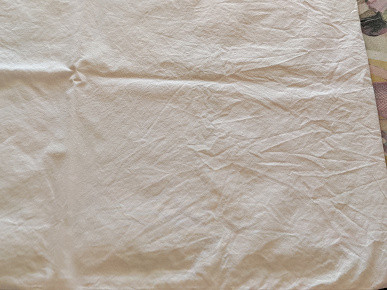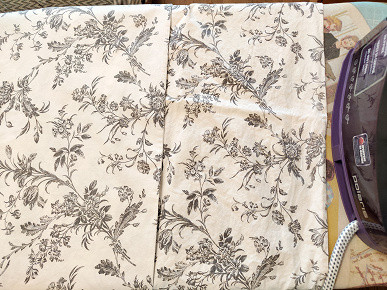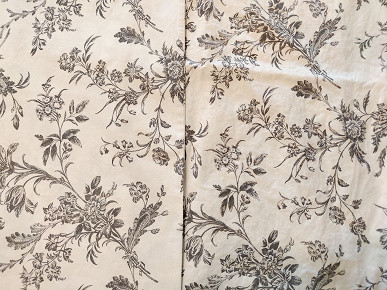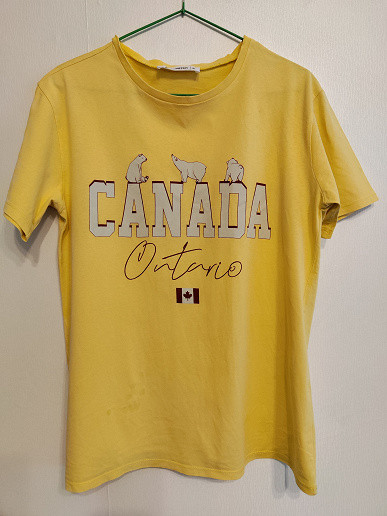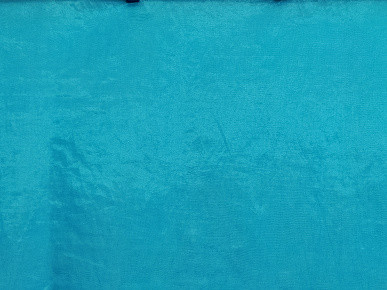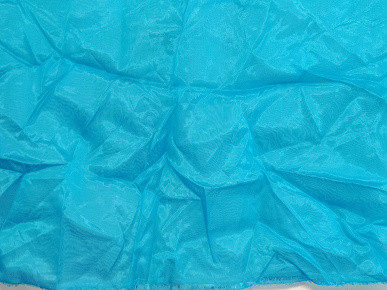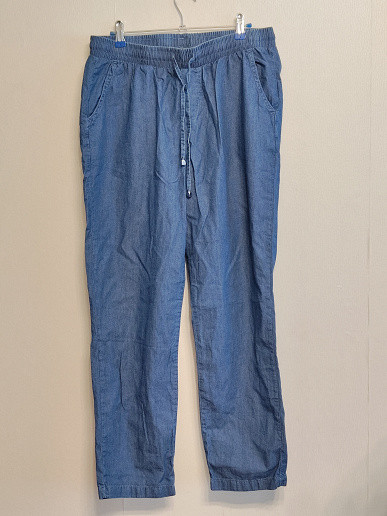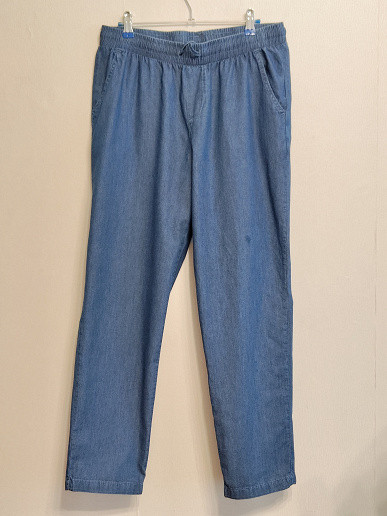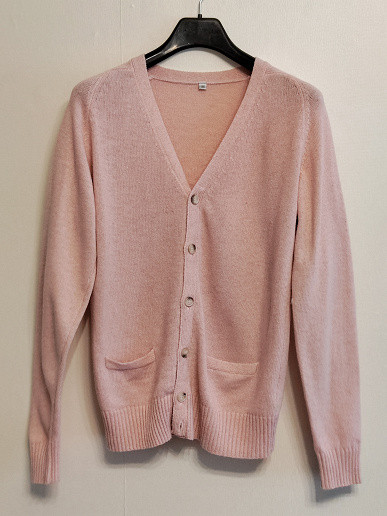Today, the review under consideration is devoted to tank steam generators, which are most often used in domestic conditions. In such devices, the steam generation chamber is integrated directly into the iron body. Steam is released to the surface as the chamber's steam cycle progresses, resulting in a short delay after the start button is pressed. Tank steam generators differ from boiler steam generators in their more affordable price, ease of maintenance, light weight and the presence of various additional functions.
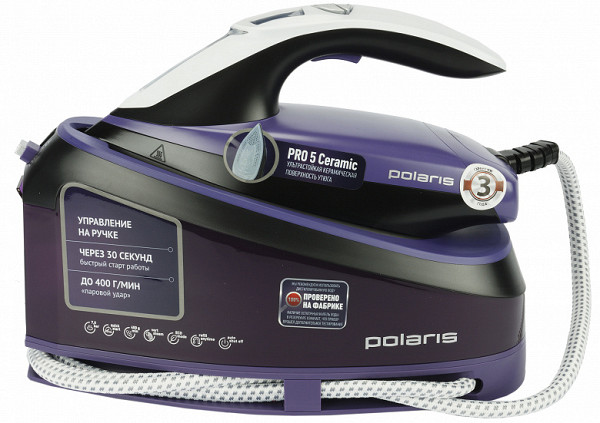
The main purpose of testing is to evaluate the ease of use of the steam generator, its effectiveness in ironing clothes, as well as compliance with the characteristics and functionality of the Polaris PSS 7510K model declared by the manufacturer.
Characteristics
| Manufacturer | Polaris |
|---|---|
| Model | PSS 7510K |
| Type | steam generator |
| Country of Origin | China |
| Guarantee | 3 years |
| Life time * | 3 years |
| Power | 3000 W |
| Operating modes | two: eco and regular |
| Indicators | on/heat function, self-cleaning function, water shortage, intense steam supply, Eco mode, auto shut-off |
| Auto shut off function | after 10 minutes of inactivity |
| Operating pressure | 7 bar |
| Steam power | 120 g/min |
| Steam boost power | 400 g/min |
| Time to prepare for work | 30 sec |
| Water tank volume | 1500 ml |
| Tank and body material | plastic |
| Iron soleplate coating | ceramic |
| Case color | purple / black / white |
| Accessories | beaker |
| Features and additional functions | anti-drip system, self-cleaning system, Smart Heat system for uniform heat distribution over the soleplate, Smart Temp technology — maintaining the optimal temperature of the soleplate, iron locking device for convenient carrying of the device |
| Flexible steam hose length | 1.9 m — on the official website, in fact — 1.55 m |
| Weight of the device with empty tank | 2.85 kg |
| Iron weight | 1.35 kg |
| Dimensions of the iron in the sole down position (W×H×D) | 12×13.5×27 cm |
| Device dimensions (W×H×D) | 18×24×34 cm |
| Network cable length | 1.95 m |
* Contrary to popular belief, this is not the time limit after which the device will necessarily break down. However, after this period, the manufacturer ceases to bear any responsibility for its performance and has the right to refuse to repair it, even for a fee.
Equipment
The steam generator is supplied in a thick cardboard box with a glossy finish. All necessary information about the Polaris PSS 7510K model, including characteristics and functional features, is presented in visual and textual information located on the sides of the package. The box is equipped with a convenient handle for easy transportation of the device.
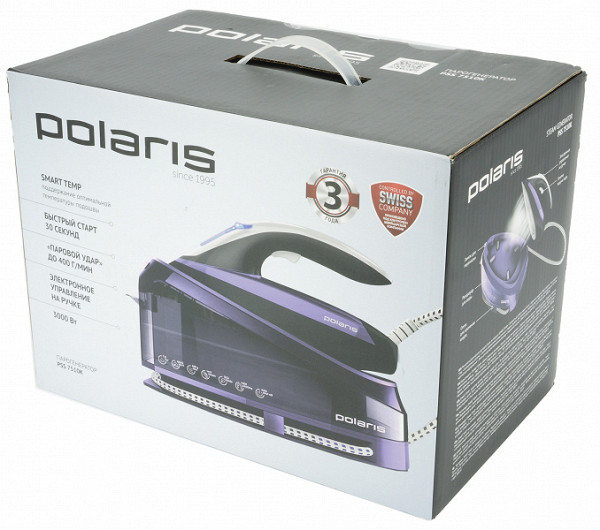
The internal space of the box is organized with the help of cardboard inserts, which securely fix the body of the steam generator, eliminating its movement during transportation. The use of cardboard inserts instead of foam plastic is quite justified, given the monolithic design of the device. The kit also includes key accessories: a measuring cup and documentation including instructions, warranty card and important information leaflet. These packaging elements do not pose a threat to the steam generator body during long-term transportation to the buyer.
At first sight
The Polaris PSS 7510K steam generator is a single design of a water tank and a steam iron.
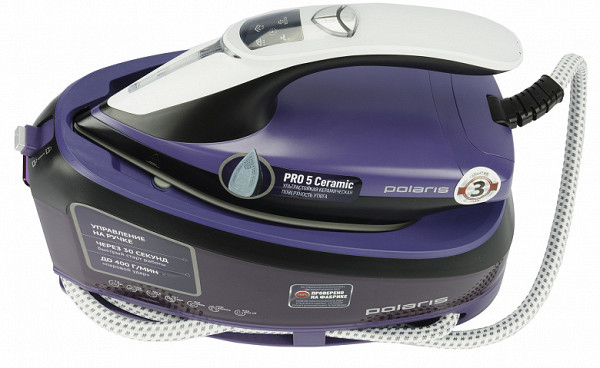
The hole for filling water in the tank is located on the front side with a width of 3.5 cm. The hinged lid shows a drawing of a tap with a drop of water. The lid snaps off easily with little effort. The tank volume is 1.5 liters. Above there is a lock for the iron on the stand, which can be unlocked by pressing the button and lowering the lock down. There are hints on the surface of the device that help the user navigate.

On the sides of the stand-tank there is information about the functions and features of the device, as well as stickers that can be removed if desired. At the base there is a special compartment for laying a steam hose. The hose fits easily and neatly around the perimeter of the stand. A 1.95 meter long power cord is connected to the back of the device. This length is considered sufficient for using the device in standard domestic conditions. There is no special mechanism for winding up or storing the network cable.

The surface of the top of the stand is a heat-resistant plastic platform designed to hold the iron in place. The iron is placed on four silicone inserts, which are raised by approximately 0.5 cm to ensure a comfortable position for the hot surface of the iron. The lower part of the iron occupies a specially designated compartment at the bottom of the platform, and the nose of the iron is fixed in the upper part, ensuring stability and immobility for safe transportation of the device.

On the back of the base you can see two rows of low legs with rubberized inserts, designed to improve grip on the surface. There is also a sticker with the technical characteristics of the Polaris PSS 7510K steam generator and a product barcode.

The size of the steam iron corresponds to the standard sizes of regular irons. There are no controls on the sleek two-tone body, all of which are concentrated on the handle. In the center of the case there is a power/heat indicator. Above is a board with five indicators, then there are three buttons. On the back of the handle, opposite the buttons, there is a button for steam supply.
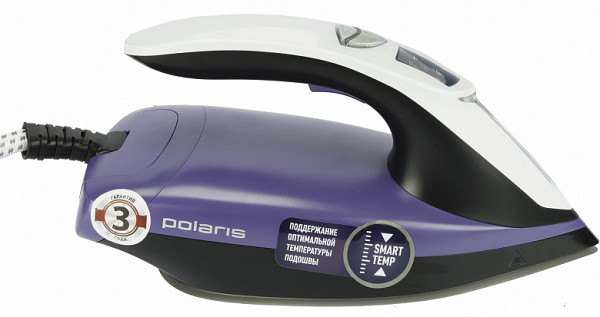
The steam hose attaches to the back (or bottom, depending on preference) of the iron body through a hinge and a 4cm flexible material casing. This cover protects the cord from damage and bending. The hinge is stationary, it can be moved up by about 3-4 millimeters.
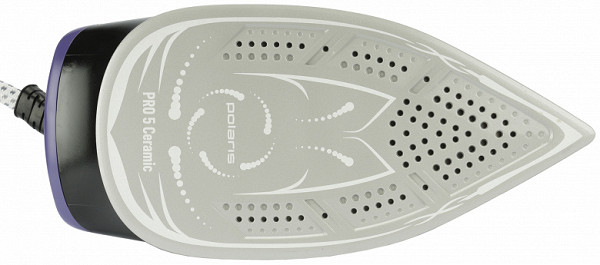
The working surface of the iron has a ceramic coating (as indicated on the sticker on the body — Pro 5 Ceramic) and many holes for steam escape. The uneven height of the sole areas is noticeable: all the steam holes are located in small recesses along the perimeter of the sides and top of the sole. The grooves gradually disappear towards the center of the sole.
The device comes complete with a standard plastic cup for pouring water into the tank. The glass has a volume of 200 ml, is equipped with a spout and volume markings on the side.

After the inspection, we did not have any comments or questions regarding the design, workmanship and assembly of the Polaris PSS 7510K steam generator. The device looks well made and is easy to use.
Instructions
In the box with the Polaris PSS 7510K steam generator we found the following: an instruction manual, a warranty card, a fold-out leaflet with important information about the device and several promotional materials.
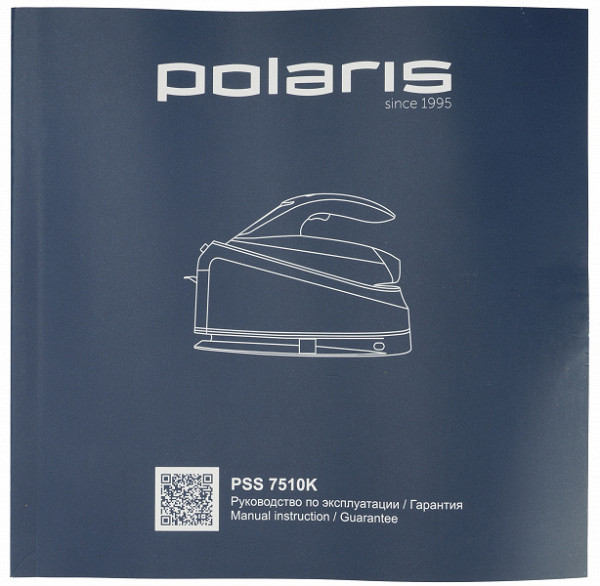
The instruction manual consists of 52 pages with full color printing on high-quality thick glossy paper. Do not be intimidated by the volume — it is necessary to read it incompletely, since the manual is presented in two languages: Russian and Kazakh. However, 27 pages in Russian may also seem like too much: what does the manufacturer want to tell us?
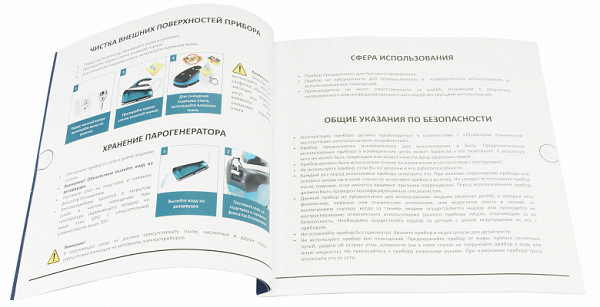
The manufacturer covers in detail all aspects of interaction with the Polaris PSS 7510K steam generator: introduces the user to the design of the device, explains in detail (and shows) how to prepare the steam generator for operation, how to use it, and also describes in detail all modes, functions and capabilities. Several pages are dedicated to safety instructions. There is also a table with possible problems and ways to solve them, as well as warranty obligations.
If you don’t want to study the full instruction manual, you can pay attention to the shortened version — the “Important Information” leaflet. Several pages smaller than A6 cover the key points of preparing the device for operation and its use. For experienced users, this will be enough to start using the steam generator.
Management
All controls are concentrated on the handle of the iron: indicators and buttons on the outside, the steam button on the inside.
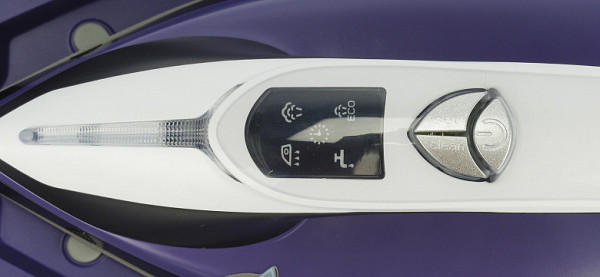
To start the steam generator after filling the tank with water, you must press the power button. After this, the heating indicator will start flashing. When the soleplate of the iron reaches the desired temperature and the steam pressure in the tank becomes sufficient, the indicator will stop flashing, which indicates that the device is ready for use. After this, you can start ironing dry or press the steam button to start steaming.
The steam supply mode is switched using the corresponding button located on the inside of the iron handle. Mode selection is possible after the device is ready:
- Two short presses activate the steam boost.
- When pressed for a long time, steam is continuously supplied as usual.
Eco mode is activated by the Set button, located in a row with other buttons on top of the handle. When this mode is activated, the corresponding indicator lights up. Eco mode helps save energy and water, which is achieved by reducing the steam supply.
The temperature of the iron soleplate is not adjustable. According to the manufacturer, this is not required thanks to Smart Temp technology, which automatically selects the optimal temperature for ironing various fabrics. During the testing process, we will check whether the operating parameters change when ironing linen and synthetic fabrics.
Exploitation
Before using the Polaris PSS 7510K steam generator for the first time, you must remove all stickers from the iron and tank, wipe the body with a damp and then dry cloth. After this, place the device on a flat and stable surface and fill the tank with water to the Max level. Then connect the steam generator to electricity; The outlet must be grounded. When you turn on a new appliance for the first time, it may take several minutes of pump operation to remove air from the system and replace it with water in the vaporization chamber. If the pump stops working, release the steam button, wait 10 seconds and press the button again. The instructions warn that sometimes when you first turn it on you may need to hold down the steam button for up to two minutes. The appearance of steam from the holes in the sole means that the device is ready for use. In our case, it did not require multiple button presses. The heating indicator stopped flashing after 28 seconds, and 10 seconds after pressing the steam button, steam began to flow in an even stream through the holes in the soleplate of the iron.
It is prohibited to fill the tank with water containing additives such as starch, perfumes, etc.
Smart Temp technology automatically selects the optimal temperature for ironing various types of fabrics. The steam generator is suitable for processing synthetic, silk, wool, cotton and linen fabrics. During testing, we successfully ironed all types of available fabrics, although we did not notice a noticeable difference in the temperature of the soleplate when processing different fabrics.
The Polaris PSS 7510K steam generator offers three modes of use:
- For dry ironing.
- For vertical steaming.
- For ironing in steam generator mode.
Although it can be used as a vertical steamer, the weight of the iron can make this process awkward for long periods of time. However, for regular ironing and steaming, the device does an excellent job.
We did not notice any difference in the volume of steam supplied in the Eco and normal modes. In both modes, steam is released only when the steam button is pressed, and the laundry is ironed equally well.
We were unable to generate a burst of steam in the middle of ironing. According to our observations, the steam burst occurs at the beginning of pressing the steam button, and then the steam flows in an even stream for as long as the user holds the button.
The function of automatically turning off the device after 10 minutes of inactivity is a convenient solution. To resume operation, press the steam button. If this is not done, the steam generator will turn off completely after 30 minutes.
Carrying the device by holding the handle of the iron is really convenient — the iron is securely fixed on the platform.
Care
Maintenance of the steam generator is simple, but mandatory. After each use, it is recommended to always empty the remaining water from the tank. To extend the service life of the device, it is necessary to regularly carry out the self-cleaning procedure after two or three sessions of use. The self-cleaning stages are familiar to anyone who has used irons or steam generators with a similar system:
- Fill the tank with water (or use the remaining water after work).
- Press and hold the self-cleaning button.
- When steam and water begin to escape from the holes in the soleplate, place the iron above the sink in a horizontal position.
- The self-cleaning procedure will be completed by a sound signal.
- For final cleaning of the steam holes on the soleplate of the iron, it is recommended to iron it with a damp cloth.
The external surfaces of the device can be wiped with a damp cloth. Do not use hard cloths, abrasives or vinegar to clean the soleplate of the iron.
Our measurements
The maximum power of the steam generator that we recorded during testing was 2730 W.
However, an attractive factor is the automatic selection of the optimal temperature when using the device. However, despite the external inspection, where nothing unusual was noticed, the question remains of how exactly the system independently selects the temperature regime and what sensors are used for this purpose.
Of greatest interest was the sole temperature during ironing of various types of fabrics. We measured the temperature using an infrared thermometer at several points on the soleplate in Eco mode during dry ironing. It was noted that the heating of the sole occurs quite evenly: the highest temperature was at the base and middle, at the top of the sole the temperature was slightly lower, but the difference was about 15%.
When processing various types of fabrics, we obtained the following results:
- Thick cotton: 140–168 °C
- Knitted cotton T-shirt: 138–160 °C
- Organza: 135–161 °C
- Light denim: 133-162 °C
These results show that there are no significant differences in temperature when ironing different types of fabrics.
The steam generator operates silently during heating. Immediately after starting the operation, small, characteristic gurgling sounds are heard, but in general the noise of the device can be assessed as very quiet.
The automatic heating shut-off function, which works after 10 minutes, works reliably, as promised by the manufacturer.
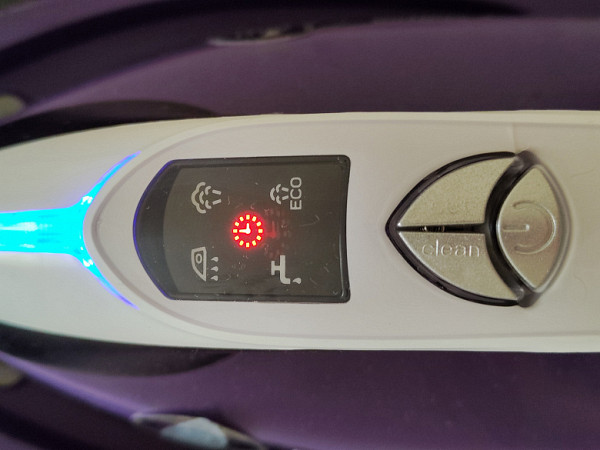
After another 30 minutes, the device completely turned off — all the indicators went out.
Practice tests
Ironing cotton fabric
We started with simple shapes but complex fabrics. For the first test, we chose pillowcases made of thick and heavily wrinkled natural fabric that had been stored in a closet for a long time. Ironed in standard steam mode. The fabric was smoothed out easily and quickly — just two or three strokes of the iron in the same place were enough for it to become even and smooth.
Inspired by our success, we grabbed two identical pillowcases from our stash to compare the Eco and standard steam modes. As a result of the work, no difference was found: in both cases, the fabric became smooth and well-groomed with the same effort. The sole temperature ranged from 140 to 168 °C, regardless of the selected steam mode.
Note that the fabric was dense and very dry. We were very pleased with the result.
Result: excellent.
T-shirt with print
We prepared the T-shirt in advance by washing and drying it on a central heating radiator in a very wrinkled state (it is not recommended to do this if the condition of your clothes and their appearance are important to you). Visually and tactilely, it looked very unpresentable. Ironed with standard steam.
Smoothing, of course, required some effort, but not as much as expected. It is important to note that the print was smoothed from the front side (everything needs to be done beautifully anyway!), which did not affect its appearance in any way. However, on the bright color of the fabric, it became noticeable that sometimes the iron “spits out” drops of water.
In this case, this is not critical, but we cannot predict how drops of hot water will affect the quality of ironing of delicate fabrics.
Result: excellent.
Organza
The fabric had been lying heavily crumpled for a long time, so it had both creases and strong folds. This test is generally considered one of the most difficult for devices designed to care for clothing: the material is synthetic, delicate, wrinkles easily, and cannot be ironed at high temperatures. In this case, we were interested in the Smart Temp technology used in the Polaris PSS 7510K steam generator. The main purpose of the test was to check the temperature change of the iron soleplate when ironing thin synthetic fabric. We used the Eco steam mode.
Steaming did the job perfectly. It would be difficult to smooth out wrinkled fabric without hot steam. However, to check whether a dry iron will not get stuck on the fabric, we conducted a test. We didn't find much sticking, but we also didn't see the smooth sliding that we've seen in other tests. Sometimes the fabric bunched up when dry ironing. This confirms that synthetic materials should only be treated with steam as this helps smooth the fabric without risk of damage.
As for the temperature, it was slightly lower than when ironing cotton, but the difference was negligible and we did not notice that the recommended temperature of 110 °C for synthetic materials was reached in any case.
Bottom line: the result is good, since there is still a risk of damage to the fabric during dry ironing.
Jeans
From previous experiments, it became obvious that the steam power and its uniformity are sufficient to smooth out dense and overdried natural fabrics. Therefore, we decided to test the steam generator on clothes made of thin denim.
Steamed at normal steam power. The sole slid easily across the fabric, leaving behind a smooth surface and sometimes drops of water.

The jeans were tidied up effortlessly, drops of water evaporated after the iron passed over them in dry ironing mode.
Result: excellent.
Vertical steaming
Finally, we decided to test the operation of the device as a vertical steamer. For this we used a warm knitted jacket made of mixed fabric. To be fair, we note that the composition of the fabric, judging by the type and quality, is dominated by acrylic rather than wool.
We processed the jacket in the usual steam mode, slightly stretching the fabric and running the hot steaming sole of the iron along it.
The steam supply was continuous and fairly uniform. In a few minutes the jacket acquired a neat and fresh look. The fabric looks great — it does not shine in places of contact with the sole, the fibers are fluffy and soft. An excellent result was obtained, but it is worth considering that steaming large items may require more time and effort — the weight of the iron plays a role here.
Result: good.
conclusions
Based on the results of testing the Polaris PSS 7510K steam generator, I was left with mixed impressions. On the one hand, the device performs its functions perfectly. It is especially worth noting the uniform and powerful steam supply, the ability to work in Eco mode, ease of use and ease of maintenance. The steam generator is securely fixed on the ironing board, it is convenient to carry it by holding the iron handle, which is a very convenient point. The large volume of the tank allows you to work for a long time without the need to add water. The iron lies comfortably in the hand, all controls are located conveniently and are easily accessible for manipulation. The sole heats up evenly at different points.
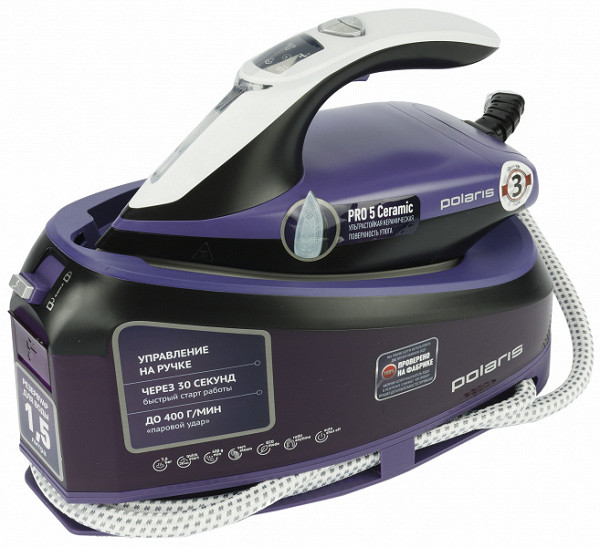
On the other hand, the anti-drip system fails from time to time, and the temperature of the soleplate practically does not change depending on the type of ironed fabric, remaining stable — it does not drop to 110 °C for synthetics and does not rise to 170 °C for linen. However, a powerful jet of steam allows you to successfully deal with overdried and heavily wrinkled fabrics without damaging their appearance. Thus, the disadvantages include the comments discovered during practical tests.
Pros:
- ease of use and maintenance
- convenient size of the device for use
- uniform heating of the sole
- uniform, powerful steam supply
- two operating modes
Minuses:
- drops of water fall on the fabric being treated
- the temperature of the sole on different fabrics varies slightly


